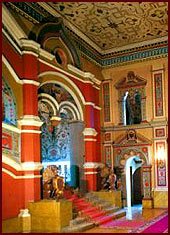 Terem
Palace Terem
Palace
The Terem Palace, easily spotted behind the Church of the
Deposition of the Robe by its eleven gilded onion domes, served
as the Imperial residence until Emperor Peter
the Great moved the Russian capital to St.
Petersburg in 1712.
The Royal Apartment of The Terem Palace with their vaulted
ceilings and wooden floors are arranged one after the other.
The windows in each room have colored glass and wide wooden
sills covered with intricate carvings. The third room of the
Palace is the Throne Room or Cabinet. The Painting in Goldenness
red tones, the coat of arms of the different Russian regions
and state double-headed eagles, and the ornament on the rotund
tiled stove make the interior of this room particular impressive.
Near the throne is the petition window. A box hung here by a
rope, and people placed suggestions in it. Suggestions, which
were almost always ignored. Even today, the Russian phrase,
"put it in the petition box",
means don't expect much from those in charge.
|
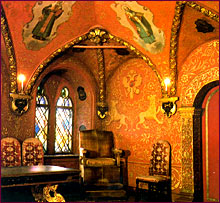 Entering
the Tsar's Private Quarters was restricted to his family, close
advisors, and most important visitors. A fierce lion, carved
in sandstone, protects the entrance. Atop the arch is a lion
with an apple in its mouth. A symbol that even the king of the
jungle wouldn't dare repeat so much as one word heard in the
Tsar's Palace. The Tsar's waiting room was heated by twin ovens.
The ovens are covered by dozens of meticulously painted ceramic
tiles. All of the hand-carved arches, emblazoned with the Tzar's
trademark, the double eagle Entering
the Tsar's Private Quarters was restricted to his family, close
advisors, and most important visitors. A fierce lion, carved
in sandstone, protects the entrance. Atop the arch is a lion
with an apple in its mouth. A symbol that even the king of the
jungle wouldn't dare repeat so much as one word heard in the
Tsar's Palace. The Tsar's waiting room was heated by twin ovens.
The ovens are covered by dozens of meticulously painted ceramic
tiles. All of the hand-carved arches, emblazoned with the Tzar's
trademark, the double eagle
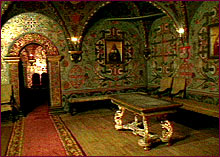 The
Boyar's Room past the waiting is a meeting room used by Russia's
feudal lords, the Boyars. It was here that matters of state
were conducted, regional disputes settled, and some say, schemes
against the Tsar hatched. The
Boyar's Room past the waiting is a meeting room used by Russia's
feudal lords, the Boyars. It was here that matters of state
were conducted, regional disputes settled, and some say, schemes
against the Tsar hatched.
Today, the Terem Palace can only be accessed from the
Vladimirsky Hall of the Grand Kremlin
Palace and is, unfortunately, out of bounds to visitors. |

|
Gatchina
Palace
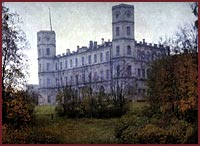 The
palace and park ensemble in the town of Gatchina ranks among
the finest works of landscape architecture of the late eighteenth
desiners. The
palace and park ensemble in the town of Gatchina ranks among
the finest works of landscape architecture of the late eighteenth
desiners.
The palace, built in the Early Classical Style to a design
by Antonio Rinaldi between 1766 and 1781, was enlarged by Vincenzo
Brenna in 1796 - 1798, and reconstructed by Roman Kuzmin between
1845 and 1860.
|
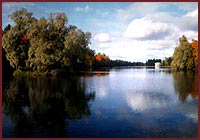 The
landscape parks, occupying an area of 700 hectare, are enlivened
by the calm waters of picturesque lakes, ponds, and canals.
The arbitrarily scattered bridges, terraces, obelisks, piers,
and gates made of local limestone add a romantic air to the
beautiful scenery. The
landscape parks, occupying an area of 700 hectare, are enlivened
by the calm waters of picturesque lakes, ponds, and canals.
The arbitrarily scattered bridges, terraces, obelisks, piers,
and gates made of local limestone add a romantic air to the
beautiful scenery.
|
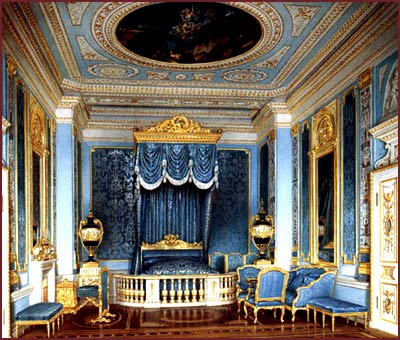 |
Gatchina
palace. Front bedroom.
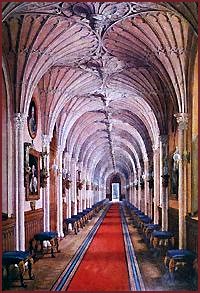 Gatchina
has the austere look of a military institution. The restrainted
limestone facade is block-like and almost without ornamentation.
Unlike most of the palaces of St.
Petersburg, which are painted in bright colors, Gatchina
is monchromatic and relies on rhythm and shallow articulation
of pilasters and windows to soften its monolithic exterior.
The palace is entirley surrounded by a deep moat, which emphasizes
the castle design of the facade. During the reigns of
Paul, Alexander and Nicholas the broad courtyard of Gatchina
was used for military parades and reviews. Gatchina
has the austere look of a military institution. The restrainted
limestone facade is block-like and almost without ornamentation.
Unlike most of the palaces of St.
Petersburg, which are painted in bright colors, Gatchina
is monchromatic and relies on rhythm and shallow articulation
of pilasters and windows to soften its monolithic exterior.
The palace is entirley surrounded by a deep moat, which emphasizes
the castle design of the facade. During the reigns of
Paul, Alexander and Nicholas the broad courtyard of Gatchina
was used for military parades and reviews.
The Gothic Corridor or Gallery is arranged along the
Arsenal Block along the apartments of Nicholas I (facing the
courtyard) and was designed by Kuzmin in 1847. The feeling of
medieval times is created by the elongated proportions, Gothic
vaults, stained glass windows and pointed arches.
|
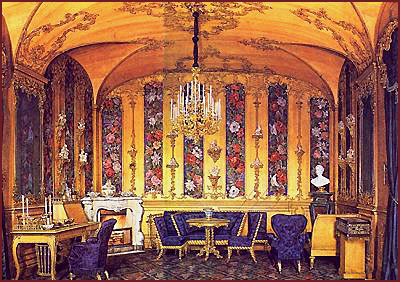
The Arsenal Block Oak Chamber designed
by Kuzmin in 1850. From a watercolor by E. Hau, 1877.
|
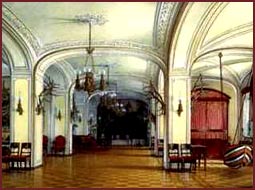 Arsenal's Hall was one of the most popular places where
emperor's family rested. Here they
Arsenal's Hall was one of the most popular places where
emperor's family rested. Here they
There was a wooden swing for children, a huge magnet from Siberia
and models of the ships.
The main feature of decoration of the Hall is deer's
antlers and stuffed animals that were killed during the emperor's
hunt. (In 1856 the collection was removed in Gatchina).
|
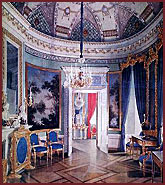 There
were even notes on stuffed animals saying where and when they
were killed. Unfortunately the Hall and all the interiors of
the XIX century were burned during the war. There
were even notes on stuffed animals saying where and when they
were killed. Unfortunately the Hall and all the interiors of
the XIX century were burned during the war.
The palace was badly damaged during the 1941 - 1945 war;
the decor suffered most of all. Restoration work in the Gatchina
Palace is still in the progress.

|
|
|
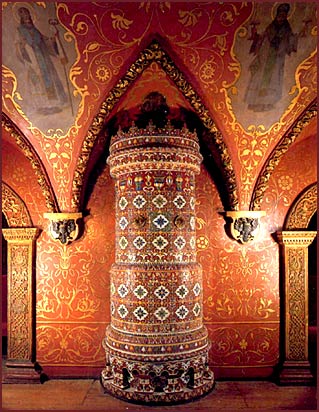
Moscow, Terem Palace, the Throne
Room.
|

|
|
Catherine Palace
The Catherine Palace facade is the longest in all of Europe,
stretching more than 1,000 feet in a fantastic profusion
of columns, windows, pilasters and statues. Catherine
Palace is a remarkable example of pure Russian baroque architecture.
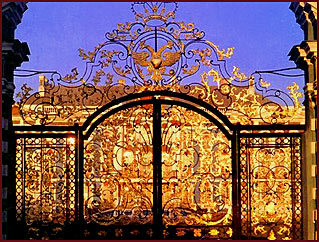
Originally the ornaments of the palace were encrusted
in gilt, which must have been a brilliant contrast against sapphire
blue walls, but the effect was difficult to keep freash and
clean, while at the same time was extremely expensive to maintain.
Later the gilt ornaments of the palace were ordered painted
over in a bronze color by Catherine II.
|
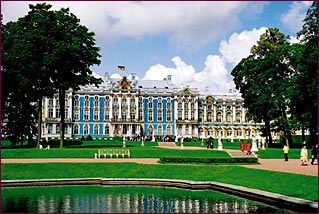
|
|
There are two fronts to the palace; one faces the
garden and the other an enormous parade ground enclosed in
a one story arc of baroque buildings and gilded railings.
The palace was originally quite small and was built by the
architect Braunstein for Catherine I (hence the palace's name),
wife of Peter I, who presented it
to her as a gift in 1718.
 After
Peter passed on and his wife died in 1727 the palace passed
to their lively, blue-eyed daughter, Elizabeth, who succeeded
to the throne in 1741 and immediately enlisted a number of architects
to enlarging her summer residence. Later the famous Italian
Architect Rastrelli took on the task and perfected the famous
palace facades in the way we see them today. After
Peter passed on and his wife died in 1727 the palace passed
to their lively, blue-eyed daughter, Elizabeth, who succeeded
to the throne in 1741 and immediately enlisted a number of architects
to enlarging her summer residence. Later the famous Italian
Architect Rastrelli took on the task and perfected the famous
palace facades in the way we see them today. |
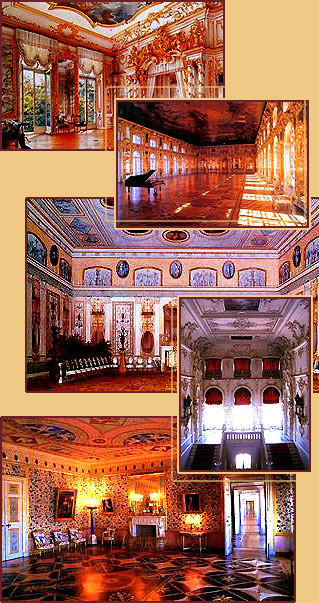
|
Originally palace was decorated
in rose and silver and was an private Imperial chapel, not open
to the public as a parish church.  Here
were performed many of the marriages of Grand Dukes and Grand
Duchesses and the chapel had many family memories for the Romanovs.
The Chapel was damaged by fire several times during the 19th
century each time was returned to its original appearance. Here
were performed many of the marriages of Grand Dukes and Grand
Duchesses and the chapel had many family memories for the Romanovs.
The Chapel was damaged by fire several times during the 19th
century each time was returned to its original appearance.
During World War II the Chapel ravaged by the Germans
in World War II. Tthe restoration of the Chapel is nearing completion
and it is again functioning as a religious space. |
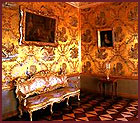 Like
the honored guests of the Russian tsars, the nowadays visitors
can admire the full splendor of the palace interiors. Many restored
rooms are open for public and contain objects of applied art,
fine furniture, Russian and European paintings, unique collections
of porcelain, amber, weaponry, artistic bronze and sculpture. Like
the honored guests of the Russian tsars, the nowadays visitors
can admire the full splendor of the palace interiors. Many restored
rooms are open for public and contain objects of applied art,
fine furniture, Russian and European paintings, unique collections
of porcelain, amber, weaponry, artistic bronze and sculpture.
To learn more about Catherine Palace please visit Tsarskoe
Selo museum website.
Click
here to learn more about Gatchina Palace.
|
|
|


